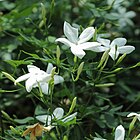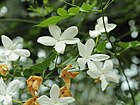Note: This is a project under development. The articles on this wiki are just being initiated and broadly incomplete. You can Help creating new pages.
Difference between revisions of "Jasminum officinale"
Shashank0204 (talk | contribs) m (→References) |
|||
| Line 68: | Line 68: | ||
==References== | ==References== | ||
<references> | <references> | ||
| + | <ref name="How to plant/cultivate">[http://temperate.theferns.info/plant/Jasminum+officinale Cultivation]</ref> | ||
<ref name="chemical composition">[Chemistry]</ref> | <ref name="chemical composition">[Chemistry]</ref> | ||
| Line 73: | Line 74: | ||
<ref name="Leaf">[Morphology]</ref> | <ref name="Leaf">[Morphology]</ref> | ||
| − | <ref name=" | + | <ref name="Jati">[https://ayuguide.com/jati-jasmine-jasminum-officinale-all-detail-of-the-plant-jati]</ref> |
<ref name="Uses">Indian Medicinal Plants by C.P.Khare</ref> | <ref name="Uses">Indian Medicinal Plants by C.P.Khare</ref> | ||
</references> | </references> | ||
Revision as of 17:17, 9 November 2022
Jasminum officinale is a Deciduous Climber up to 10.00 metres tall. It is harvested from the wild for local use as a food, medicine and source of materials.
Contents
- 1 Uses
- 2 Parts Used
- 3 Chemical Composition
- 4 Common names
- 5 Properties
- 6 Habit
- 7 Identification
- 8 List of Ayurvedic medicine in which the herb is used
- 9 Where to get the saplings
- 10 Mode of Propagation
- 11 How to plant/cultivate
- 12 Commonly seen growing in areas
- 13 Photo Gallery
- 14 References
- 15 External Links
Uses
Ringworm, Relieve tension, Sensitive skin, Depression, Nervous tension, Impotence, Frigidity, Menstrual disorders, Weak digestion.[1]
Parts Used
Chemical Composition
Common names
| Language | Common name |
|---|---|
| Kannada | |
| Hindi | Chameli |
| Malayalam | |
| Tamil | |
| Telugu | |
| Marathi | Jati-jai |
| Gujarathi | |
| Punjabi | |
| Kashmiri | |
| Sanskrit | Mallika |
| English | Common Jasmine |
Properties
Reference: Dravya - Substance, Rasa - Taste, Guna - Qualities, Veerya - Potency, Vipaka - Post-digesion effect, Karma - Pharmacological activity, Prabhava - Therepeutics.
Dravya
Rasa
Guna
Veerya
Vipaka
Karma
Prabhava
Habit
Identification
Leaf
| Kind | Shape | Feature |
|---|---|---|
Flower
| Type | Size | Color and composition | Stamen | More information |
|---|---|---|---|---|
| {{{5}}} |
Fruit
| Type | Size | Mass | Appearance | Seeds | More information |
|---|---|---|---|---|---|
Other features
List of Ayurvedic medicine in which the herb is used
Where to get the saplings
Mode of Propagation
Seeds, Cuttings of half-ripe wood, Cuttings of mature wood, Air layering.
How to plant/cultivate
Succeeds in a good well-drained loam, preferring a sunny position. Very shade tolerant, it succeeds on a north facing wall.[4]
Commonly seen growing in areas
Shrubberies, Forests, Humus-rich soils, Valleys, Ravines.
Photo Gallery
References
- ↑ Indian Medicinal Plants by C.P.Khare
- ↑ [Chemistry]
- ↑ [Morphology]
- ↑ Cultivation
Cite error: <ref> tag with name "Jati" defined in <references> is not used in prior text.
External Links
- Pages with reference errors
- Ayurvedic Herbs known to be helpful to treat Ringworm
- Ayurvedic Herbs known to be helpful to treat Relieve tension
- Ayurvedic Herbs known to be helpful to treat Sensitive skin
- Ayurvedic Herbs known to be helpful to treat Depression
- Ayurvedic Herbs known to be helpful to treat Nervous tension
- Ayurvedic Herbs known to be helpful to treat Impotence
- Ayurvedic Herbs known to be helpful to treat Frigidity
- Ayurvedic Herbs known to be helpful to treat Menstrual disorders
- Ayurvedic Herbs known to be helpful to treat Weak digestion
- Herbs with Flowers used in medicine
- Herbs with common name in Hindi
- Herbs with common name in Marathi
- Herbs with common name in Sanskrit
- Herbs with common name in English
- Habit - Deciduous climber
- Index of Plants which can be propagated by Seeds
- Index of Plants which can be propagated by Cuttings of half-ripe wood
- Index of Plants which can be propagated by Cuttings of mature wood
- Index of Plants which can be propagated by Air layering
- Herbs that are commonly seen in the region of Shrubberies
- Herbs that are commonly seen in the region of Forests
- Herbs that are commonly seen in the region of Humus-rich soils
- Herbs that are commonly seen in the region of Valleys
- Herbs that are commonly seen in the region of Ravines
- Herbs
- Pages without herbs images






